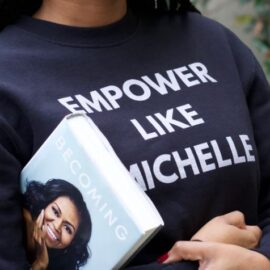
Is there a job that you’ve been wanting for a long time? Do you know how to dream big?
In Get Your Sh*t Together, Sarah Knight provides strategies that can be used to get your life together for small everyday tasks and long-term planning and goals. You can apply her advice to the realm of your job and your money.
Learn how to dream big and accomplish anything below.
Plan For The Job You Want
According to Knight, the first part of having your shit together at work is having your small shit together—that means being on time, managing your to-do list effectively, and staying ahead of your inbox.
But you also want to make sure you still know how to dream big and are on track to have the job you want. If you haven’t found it yet, consider whether you want to advance in your current field or whether you’re looking for a career change. If you have a goal at work, then you need to ask yourself or your boss an important question: What do I need to do to get where I want to go? What you’re asking for is a plan: You are saying, “This is where I want to go, and I want to know how to get there.”
(Shortform note: While Knight suggests asking, “What do I need to do to get ahead at work?”, marketing expert Seth Godin, author of Linchpin, suggests asking, “What do I have to offer at work?” Godin argues that the way to advance in your career is to make yourself invaluable to a company, to demonstrate your unique abilities and passion to position yourself as an indispensable “linchpin” within your work environment. According to Godin, linchpins are people who see the work they do as a gift to others, follow their own directions rather than anyone else’s, and commit to being their authentic selves. Godin argues that becoming a linchpin is the key to making your work, and your life, more fulfilling.)
The last part of having your shit together at work is establishing healthy boundaries. Knight insists on the importance of protecting your personal time as fervently as you do your work time, creating space in your life for things outside of work that bring joy and relaxation. Remember, having your shit together is not only about working smarter and more efficiently; it’s also about creating a better-balanced, more satisfying life. Establishing a healthy work/life balance helps prevent burnout that has the potential to harm your job performance and, more importantly, your mental health.
(Shortform note: Setting boundaries can help avoid burnout, which has become an increasing issue in workplaces all over the world. According to Celeste Headlee, author of Do Nothing, the rise of “hustle culture” is largely to blame for increasing rates of burnout. Headlee argues that people’s value shouldn’t be measured solely by how much they do. Like Knight, she advocates for a balanced lifestyle, which includes cultivating non-work related pursuits.)
Save for the Future
Being on top of your finances is also part of getting your shit together. Knight advises taking a hard look at your income and expenses and making a plan that suits both your current reality and future goals. In particular, Knight focuses on the value of an Individual Retirement Account (IRA) because of the benefit of compound interest. The sooner you start putting money away in an IRA, the more financial stability you’ll have later in life. Like most things worth having, Knight explains, financial stability isn’t achieved overnight, but it’s very achievable if you take disciplined, consistent steps toward your long-term financial goals.
| What Is an IRA? An IRA, or Individual Retirement Account, is a type of investment account specifically designed for retirement savings. It offers tax advantages and the potential for significant growth over time. By investing in an IRA, individuals can allocate their funds in various assets such as stocks, bonds, mutual funds, and more. The contributions and earnings in an IRA grow tax-deferred or tax-free, depending on the type of IRA chosen. Many employers also offer to match a portion of the contributions made by employees. This means that for every dollar an individual contributes to their IRA, the employer contributes an additional amount, thereby boosting the retirement savings even further. There are two main types of IRAs: 1. Traditional IRA: Contributions to a traditional IRA are often tax-deductible, lowering an individual’s taxable income in the year they contribute. The earnings in the account then grow tax-deferred until withdrawals are made during retirement. However, it’s worth noting that the withdrawals are treated as ordinary income and taxed accordingly. 2. Roth IRA: Contributions to a Roth IRA aren’t tax-deductible since they’re made using after-tax dollars. However, the earnings in a Roth IRA grow tax-free, and qualified withdrawals made during retirement aren’t subject to income tax. |






